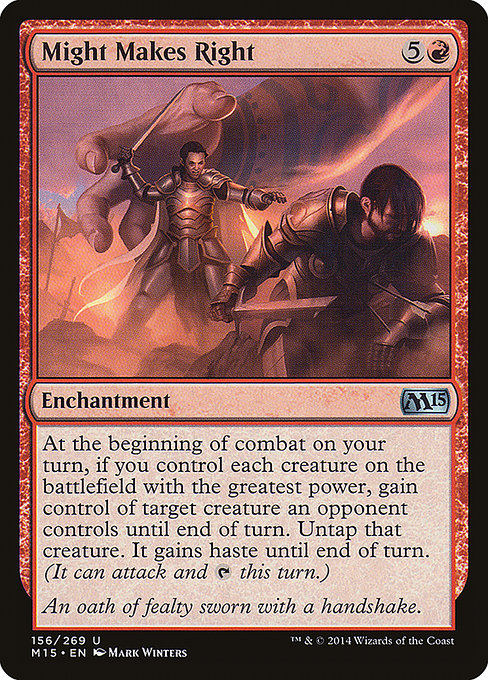
Image courtesy of Scryfall.com
Variance-Driven Interactions in Might Makes Right: A Red-Tempo Case Study
Red magic often thrives on tempo, risk, and the thrill of momentary dominance. Might Makes Right embodies a particularly spicy flavor of variance: a condition-laden crown jewel that can catapult a game into a single burst of tempo, or sit inert on a crowded battlefield. This blue-collar enchantment from Magic 2015 asks you to orchestrate a precise board state—one where you control every creature sharing the greatest power on the battlefield—before it translates into direct disruption. When the stars align, you snag an opponent’s big threat, untap it, grant it haste, and let it swing for a punishing turn. When they don’t, you’re left staring at a six-mana enchantment that’s actively doing nothing beyond its own pretty frame. 🧙🔥💎⚔️
Let’s anchor the discussion in the card’s essentials. Might Makes Right is an enchantment from the core set Magic 2015 (M15), color red, with a mana cost of {5}{R} and an uncommon rarity. Its oracle text reads: “At the beginning of combat on your turn, if you control each creature on the battlefield with the greatest power, gain control of target creature an opponent controls until end of turn. Untap that creature. It gains haste until end of turn. (It can attack and {T} this turn.)” That last clause—granted access to attacking and tapping on the same turn—is where a lot of the magic (and risk) happens. This is not a one-card win condition; it’s a strategic lever that only activates when your board is carefully tuned. The flavor text, “An oath of fealty sworn with a handshake,” deepens the sense that red in this instance is less about raw burn and more about transactional, high-stakes maneuvering. 🎨
In terms of play pattern, the variance is twofold. First, the prerequisite is non-trivial: you must control all the creatures that currently have the greatest power on the field. If you’re behind or the opponent has multiple high-power creatures, the threshold shifts and the window closes. Second, the payoff—stealing a creature—depends on what your opponent has out at that moment. You could flip a game by stealing a late-game beater and smashing face with it, or you could effectively pass the turn with nothing to show for your investment. That tension is the heartbeat of variegated tempo decks that aim to maximize payoff when the stars align, while remaining clunky when they don’t. 🧙🔥
Let’s break down the practical strategy. In the late game, Might Makes Right shines when you’ve successfully navigated trades to leave you with control of the battlefield’s power hierarchy. Here are a few actionable angles:
- Board control and “greatest power” calculus: Track who has the largest creature on both sides. If you can engineer a lineup where all the top-power creatures are yours, you open the door for a surprise tempo swing. This often means leveraging removal and combat tricks to whittle down or redistribute power values so your side remains dominant at the top. ⚔️
- Power alignment for maximum payoff: Use buffs or removal to sculpt a stable top tier on your side, ensuring you’re qualified for the trigger even as the battlefield changes. When you can maintain that authority, you can steal the biggest threat, untap it, and give it haste—often enabling a devastating alpha strike the same turn. 🎲
- Tempo chips and risky plays: Consider the timing; casting Might Makes Right too early can stall your momentum, but resolving it on a turn where you can untap and attack with the stolen creature can create pure chaos for your opponent. Red’s strength is acceleration; this card asks you to pair acceleration with careful state management. 🧙♂️
- Commander-level synergy: In formats like Commander, Might Makes Right plays into political intrigue, often becoming a tool to flip the table when you manage to keep your top-power creatures aligned. The enchantment’s prestige lies in how unexpectedly a single combat step can shift the tide. 💎
From a design perspective, Might Makes Right is a fascinating study in variance-enabled design. It embodies the tension between a powerful but conditional effect and the requirement to maintain a highly specific battlefield state. The card’s red mana symbol and rarity reflect a gamble—you’re wagering on your board development to outpace your opponent just long enough to snatch victory from mid-combat chaos. The flavor text and Mark Winters’s art communicate a moment of fragile trust—an oath that could be the last thing your opponent expects. It’s a compact lesson in how variance can be engineered into a seemingly straightforward effect, turning a borderline mid-range enchantment into a potential game-changer. 🎨
On the collecting and value side, Might Makes Right sits in the realm of budget-friendly staples for M15-era red decks. The card’s base price tends to hover around a few cents to a dollar for non-foil versions, with foils gaining modest premiums. Its status as an uncommon from a core set keeps it accessible, making it a nice historical touchstone for players who enjoy reminiscing about early-2010s design ethos and red’s brash experimentation. For collectors, the art, flavor text, and the nostalgia factor add a layer of fond recall for sandbox-era magic, where the rules-hacking feel of a single, well-timed steal could redefine a game. 🧙♂️
As you chase variance-driven moments, you can pair Might Makes Right with other red tools—bounce or sacrifice effects to sculpt the top-power distribution, or pressure your opponent with a flurry of attacks that deny them time to respond. Its place in your deck is about risk management: the payoff is substantial, but only if you can sustain the prerequisite. If you’re looking to explore that line of red tempo and combat trickery, Might Makes Right offers a compact, high-variance sandbox where every combat step could tilt the battlefield in dramatic fashion. 🧙🔥
MagSafe Card Holder Phone Case Polycarbonate